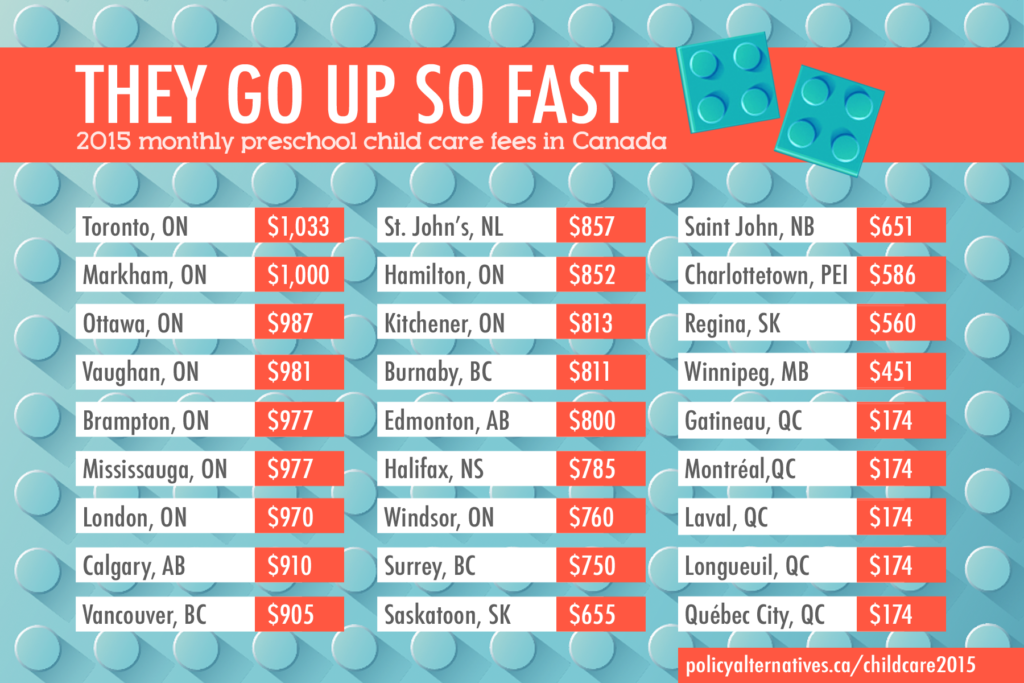Child care—in theory and practice—has signposted my life for well over a decade. The practice part started in 2004 when, newly pregnant with a daughter, my partner and I called every child care centre in Ottawa to try and secure a space for when she would need it 18 months later. When she was born, I took six months off work to care for her at home and my partner did the same after that. It wasn’t until our daughter was 11 months old that we found out she would have a care space within walking distance from our house. It felt like we’d won the lottery.
In the summer of 2006, our 13-month-old daughter entered the infant program at a unionized, parent-run daycare co-op. Within two weeks of playing with the other children she was crawling. Within three more she was walking. Her vocabulary, already impressive, grew exponentially. While the direct benefits were and continue to be obvious, as a family we also gained a lot from the professionalism, care, love and support of the many caregivers who worked with our kid through infant, toddler, preschool and kindergarten programs.
In the spring of 2009, with our daughter spending half her day in junior kindergarten and the other half in daycare (this was before full-day kindergarten had arrived at our school) I became pregnant with our second child. The four-and-a-half years between our kids speaks directly to two issues: the cost of child care, and student loan repayments. With the student loan paid off, we could afford to have another child—or, more accurately, we could afford the child care fees for two kids simultaneously.
Our son was born late that same year, and once again we split the year of parental leave 50/50. This time, of course, we had to incorporate school and daycare pickups into our daily commutes. And though our family was grandfathered at the daycare centre (so we didn’t have to go back on the waiting list), no spot was available when our son needed one. We managed to find six months’ of temporary homecare with a very capable, experienced woman in the neighbourhood who also walked kids to and from school. Then, at the age of 18 months, our little boy entered the toddler program downstairs from his sister who was enrolled in the senior kindergarten program in the afternoon. While there were two different drop-offs, at least we had a central pickup that was more-or-less on the way home from work.
Things got more complicated over the next three years, as many parents of two children in child care find out. I was responsible for drop-offs, my partner (on his bike) for daycare pickup while I got groceries and made dinner, and we took turns with homework help and story time. Our schedule was balanced, barely. Doctor’s appointments, colds, work events or inclement weather could throw off everything without warning—and frequently did. Fortunately, both our workplaces have family-friendly policies so if we had to work from home or bring a child in for an hour or two we could accommodate it. But don’t ask me how we managed—car-less and in the winter—the year I broke my leg and was housebound for two months.
The year 2014-15 was the first time both kids were at the same school, our son now in full-day kindergarten, which had just started in Ottawa. We had one location for drop-off and pick-up and it was—bonus!—on the way to and from work. (I can talk your ear off about how much time and joy this one simple thing can add to your life, particularly if you do not own a car.) With only pre- and post-school care to pay for, our child care expenses were significantly reduced.
But that stage was short-lived: our neighbourhood catchment school switched, after the board-wide accommodation review, to one less convenient from a commuter’s perspective. This fall, arrangements for our youngest changed for after-school care. And, on a more emotional note, as of this summer our eldest, now 10, no longer required the daycare’s satellite programs, including the extended day program at her grade school. After nine years, over 30 full- and part-time caregivers, extracurricular activities, carefully prepared meals, arts and crafts, sign language, day trips and satellite programs with her school, she has graduated from the daycare that taught us all so much.
Our decade-long child care journey is coming to an end. In recapping it here, I’m reminded that alongside the warmth, support and gratitude I experienced is the emotional rollercoaster: the wave of panic about whether we could find a space before going back to work, the relief when we did, the overwhelming shock at the cost of child care, followed by the rejigging of the household budget to manage it effectively, and finally the plateau of stability—until the next child came along, when it all repeated. I’ll remember this period as a prolonged state of tentative existence where anything—a cold, a snowstorm, a meeting—could upset the delicate balance we’d managed to achieve.
I’m also conscious that, in the current market that we pretend passes for a child care system, we are the lucky ones:
<li>We are a dual-income household.</li>
<li>Our kids do not have special needs.</li>
<li>We are not precariously employed.</li>
<li>We are not socioeconomically or racially marginalized.</li>
<li>We do not live in a rural community.</li>
<li>While car-less, we have access to public transportation.</li>
<li>We have flexible, child-friendly, unionized, accommodating workplaces.</li>
<li>We could take time off at fully topped-up pay to be with our kids for the first 12 months.</li>
<li>We work (mostly) regular hours.</li>
<li>We are walking- (or biking- or, in the winter, sledding-) distance from our public school and our day care, both of which are excellent.</li>
Is the lesson here that in a country that does not adequately prioritize the care and well-being of its youngest and most vulnerable, you have to be my kind of family—with our luck, location, and privilege—to navigate, with some mishaps, the patchwork, piecemeal, punitively priced market-based child care system that does exist, without devastating hardship? If so, that is an excruciatingly low-water mark for one of the wealthiest countries in the world.
We know—here’s the theory part—what’s required to meet the changing needs of today’s families, and how out-of-reach (because there are not enough spaces, because those that exist are too expensive) child care is for too many families. This has been starkly detailed in our report They Go Up So Fast: 2015 child care fees in Canadian cities.
We need a national child care program that responds to and meets the needs of kids from coast to coast to coast; that is inclusive, accountable and of high quality; that values and fairly compensates the tremendous work of caregivers; that is flexible and responsive to parent and community needs; that is stable, adequately funded, and helps to build vibrant, equitable, compassionate, cohesive communities.
This commentary is based on the editorial from the summer 2015 issue of Our Schools / Our Selves, Moving Beyond Baby Steps: Building a child care plan for today’s families.
Erika Shaker is Director of Education and Outreach at the CCPA. She remains eternally grateful to the caregivers who, with love, expertise and professionalism have supported her family, and especially her kids, over the past decade. Follow Erika on Twitter @ErikaShaker.








